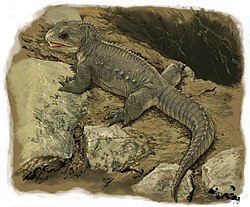| McCoy Brook Formation | |
|---|---|
| Stratigraphic range: | |
 Breccia in the McCoy Brook Formation (Jurassic), Wasson's Bluff, Nova Scotia. | |
| Type | Geological formation |
| Unit of | Newark Supergroup Meriden Group |
| Sub-units | Scots Bay Member |
| Underlies | Erosional top |
| Overlies | North Mountain Basalt |
| Thickness | more than 230 m (750 ft) |
| Location | |
| Coordinates | 45°24′N64°12′W / 45.4°N 64.2°W |
| Approximate paleocoordinates | 27°24′N13°18′W / 27.4°N 13.3°W |
| Region | Nova Scotia |
| Country | Canada |
| Extent | Bay of Fundy |
| Type section | |
| Named for | McCoy Brook, Nova Scotia |
The McCoy Brook Formation is a geological formation dating to roughly between 200 and 190 million years ago and covering the Hettangian to Sinemurian stages. The McCoy Brook Formation is found in outcrops around the Bay of Fundy, Nova Scotia. [1]









